Track & Bridges
Dremel: How to Fix Broken Track.
Aug 20, 2008


By Jon C.A. DeKeles
LSOL.com Editor in Chief |
Author
Bio
We were going to need to cut out and replace a section of track and there were also some gaps in the track that needed to be touched up as well. Our problem was our old battery power Dremel tool had died.
|
If you remember from one of our previous articles we had spent a lot of time getting our railroad ready for the July 4th holiday weekend. We knew that the track need to be perfect and we had one major problem on the rails and a few small ones to take care of. We were going to need to cut out and replace a section of track and there were also some gaps in the track that needed to be touched up as well. Our problem was our old battery power Dremel tool had died. We had gotten one several years ago and were never impressed with it as it had rotation speed much slower than a wall powered kind. When you are cutting brass, but especially stainless steel track, you want as much speed as you can get. I was pleasantly surprised to see that the options on a battery powered cordless rotary tool had improved. They now use Lithium-ion batteries and enough power to even power a Large Scale locomotive. I check several options and ended up with a Dremel 10.8V Lithium-ion Cordless Rotary Tool Kit. It was less than $100.00 It said on the box that the Lithium-ion battery holds charge while in storage for two years so the tool would always ready when you need it. (We shall see.) The set also includes 60 genuine Dremel accessories. Of course, one small grinding pad is one accessory.
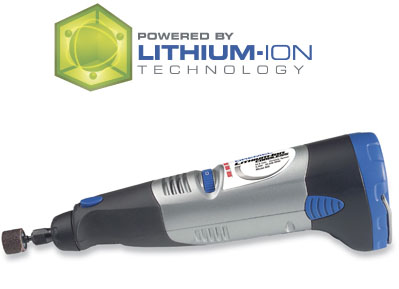
Here are the features as presented by the manufacturer. Features - Variable speed from 5,000 to 35,000 rpm to match the proper speed required
- High capacity 10.8V Lithium-ion battery for longer run times
- Always Ready--Battery holds a charge 6 times longer than standard NiCd batteries
- Battery fuel gauge lets you know when it's time to recharge
- Comfort grip housing for easier handling and better tool control
- Compact and lightweight for easier handling and less fatigue
- Two year warranty
Here are the specifications as presented by the manufacturer. Specifications - Battery Lithium Ion Battery
- Speed Variable (5,000 - 35,000 rpm)
- Voltage 10.8V DC
- Weight (lbs.) 14 oz / 0.424 kg
We found the tool was easy to use and not too heavy. There is still the problem of the battery being large at the end. This makes for some difficulty in making some cuts. Having an attachable flex head like I a do for my wall plug Dremel would be nice.
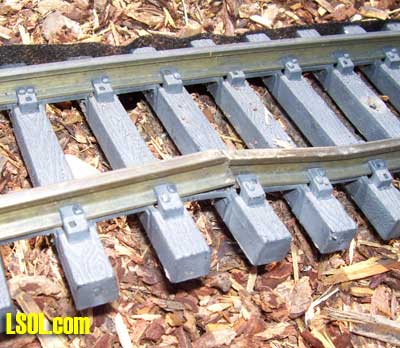
Here is what happens to Aristo-Craft brass track after you drop a large rock on it and then let the bent track sit out all winter. The track was not broken when I dropped the rock. It was just bent as you see in the right of the picture. We actually were still able to run trains over the dip and they did not fall off the track. We found that amazing. Well we stopped running for the winter. as the track was covered with 4 feet of snow. When the snow finally melted we found that the track had split right at the point of the most pressure in the track from the dent that happened because of the rock. Well, now the train would not go over this track problem and it was time for some repair work. 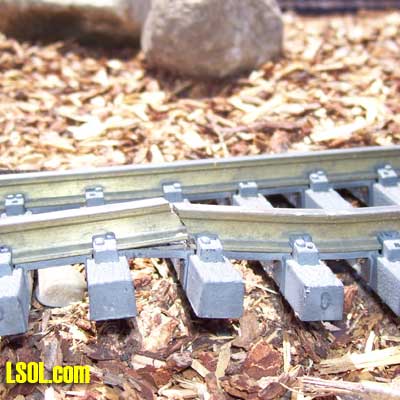
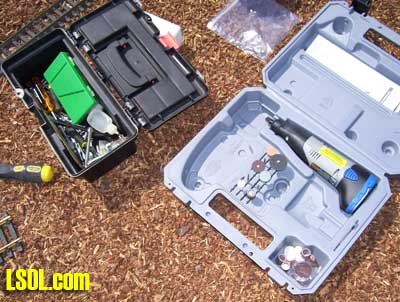
Here is my small black tool case to the left and the case that my Dremel came with on the right. I would recommend looking at a model that comes with a case. It is very nice because there is a place to set the tool with the attachments on the unit when not in use. The holder is shaped in such a way that what ever attachment is installed does not touch the case. With my other tool I would place it on the table with weight resting on the attachment. Of course I would inevitably break the pad with the weight resting on the attachment. 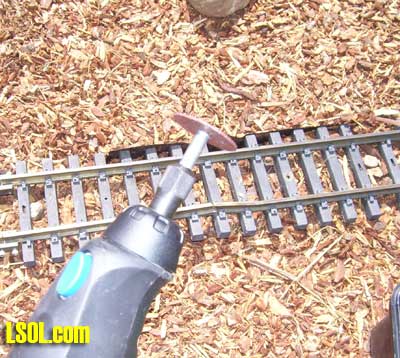
For cutting I used one of the common cutting disks. They work great on brass, but on stainless steel, you can end up with a disc that is a lot smaller fast real fast as the stainless track is a lot harder than brass and harder than your cutting wheel.
These are handy cutting disks as you can use them to cut and also use them to sand the end of the track flat. 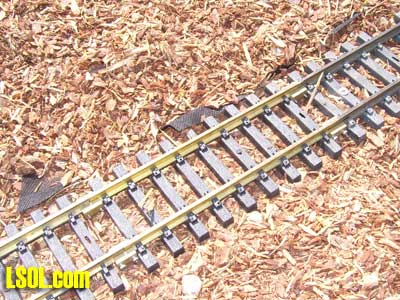
Here is the cut out piece of track in place and ready to go. I have held it in place with rail clamps. It makes it easy to install and I do not have to tap and drill holes or try to force on rail joiners as well.
Another problem we had was some of the joints had gaps larger than we liked caused by the expanding and contracting of the track over the winter and then now into the summer months. 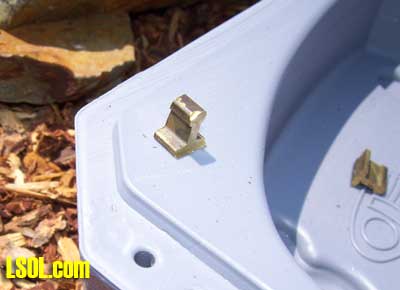
The first thing we do is cut off a small piece of rail to fill the gap. We do not want a piece that is so long that it will be super tight in the gap. We want the ability for the track to still have some room at the joints. When you are cutting small pieces like this be VERY CAREFUL how you handle them after you cut them. They will burn your fingers! Do not cut the piece off and then try to pick it up. OUCH. Use a pair of pliers to handle the just cut pieces. 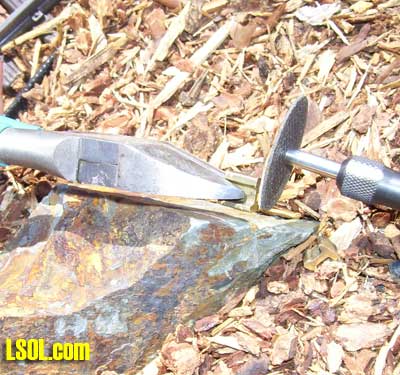
It is important to use your Dremel tool to flatten both sides of the rail. Remember this will heat up the rail also and you should avoid touching the rail right after you sand. I found it easier to place my diagonals against a flat surface when using the Dremel to sand the ends.
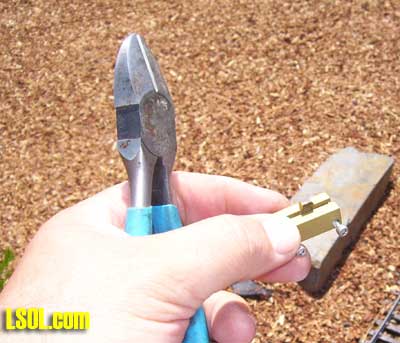
The next thing I did was to get an extended rail clamp. What is that? It is a rail clamp that is twice as long as a regular rail clamp. I slid the piece that I had cut and place it in the middle of the clamp and then attached it to the area in question. 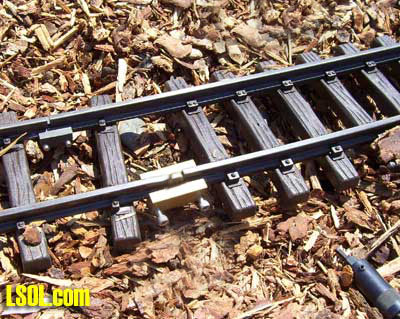
Here is a look at the extended rail clamp in place with the new extra piece of rail in the middle. There is still a small gap on each side in case the rail needs to expand again. This is an easy way to make a fix without having to remove full sections of track.
| Flexible Attachment |
| Jon, Hopefully you didn't discard the flexible attachment from the older corded Dremel?, it should be compatible with the new 10.8v cordless. |
| Kevin Lepel - 08/20/2008 - 06:13 |
| Eye Safety et.al. |
| Jon, I would encourage you to ALWAYS promote eye wear when using something such a cutter on a Demel. Small fragments of brass can create a real problem when it comes into contact with the eye. Also, thanks to Kevin Lepel, I have my question answered. "Could an old flexible attachment be used on the new tool?" |
| Tom Knight - 08/20/2008 - 09:13 |
| Eye Safety |
| Tom, I agree. I always were eye protection whenever I use any power tool. The loss of an eye is a major possibility with anything that can create fragments of any kind. I also make sure that the safety guards are in place on those tools as well. I manage to cut my fingers with a hobby knife so I want to be sure that anything with power has a guard so that I can't do any damage to any part of my body. My uncle, a cabinet maker, didn't believe in leaving the guards in place and managed to cut off parts of several fingers in the process. Noel |
| Noel Widdifield - 08/20/2008 - 09:43 |
| Dremel Tool |
| I got one of those a couple of years ago. Not been impressed by it. It has almost no torque. Enlarging openings with a cutting bit, or cutting with a disk, the motor slows down and stops unless the thing is turning full blast. What good is a variable speed tool that only functions on warp 9. The battery seems fully charged, just no torque. Does yours bog down easily? |
| Dick Friedman - 08/20/2008 - 10:34 |
| Cutting disks |
| I buy the fiber reinforced cutting disks at the hardware store, they are larger then the Dremel disks and will cut stainless rails well. But like you said they too wear down faster on stainless then brass. As for cutting short sections of rail I did that to separate my mainline from my one reverse loop on the entrance leg. The short rail has insulated joiners on both ends, that way I can run longer trains without shorting my mainline and loop together after the relay controller reverses the polarity of the mainline. As for gaps I usually draw them closed instead of filling them. I put a small pair of vive grips vertically on both rails then slowly draw them together with a small "C" clamp. |
| David A. Maynard - 08/20/2008 - 17:24 |
| Dick Friedman |
| Dick, I would suggest letting the cutting disk do more of the work. I know what you mean about being rather anemic when it comes to cutting, but if you take a little longer and just let the weight of your drill do the pushing, you will have better and faster cuts. Now if your not pressing hard and its still bogging down, I would suggest making sure the cutter is in good condition and the correct cutting wheel is being used. Great work Jon...but what else could I expect |
| Clifton MunzPhelps - 08/22/2008 - 10:01 |
| Dremel |
| Jon, I bought the same model as your at Lowe's for Christmas, <$75.00. I am throughly impressed with longevity of the battery. I have been successful in cutting .332" Stainless Steel rail and still have a little charge left over. The older models can't hold a candle to these newer ones, though, I'm keeping the older one for the slower speeds for delicate materials. |
| Arthur Raynolds - 02/11/2009 - 14:05 |
Top of Page
|



